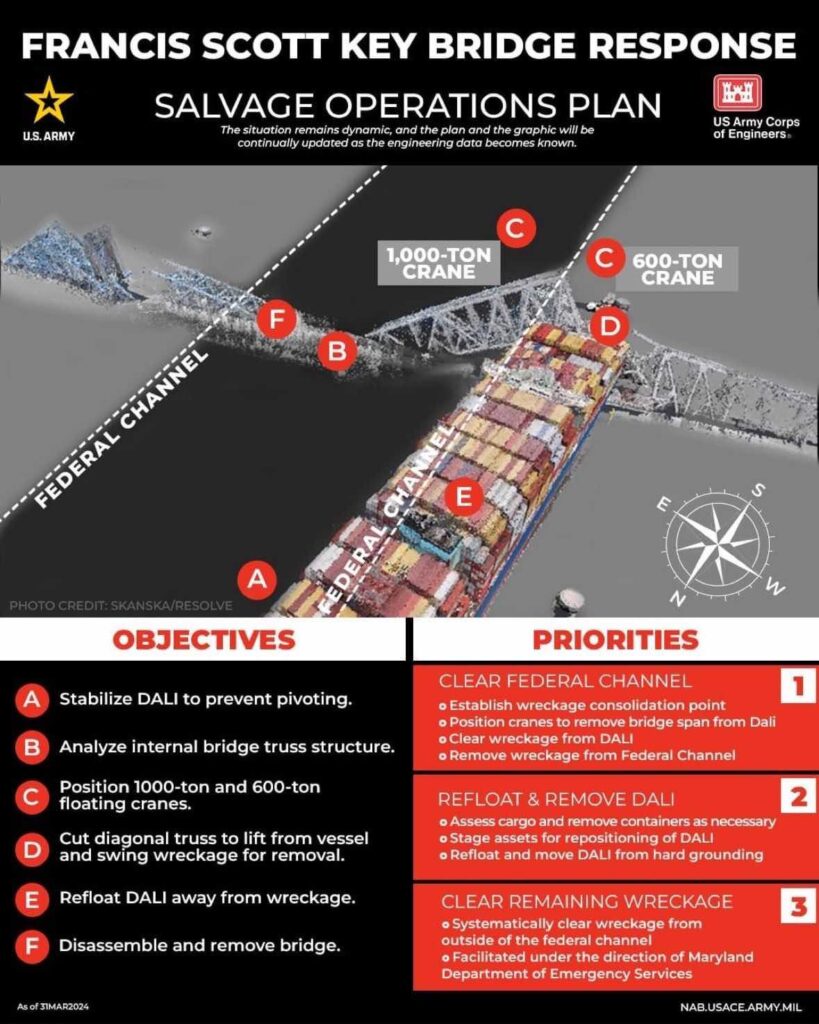Baltimore clear-up operation moves into high gear

It has been a very busy Easter weekend for those involved in the clear-up at Baltimore port with the first segments of the downed bridge removed and plans developing on how best to shift the badly damaged Dali containership.
The captain of the port is preparing to establish a temporary alternate channel on the northeast side of the main channel in the vicinity of the downed Francis Scott Key Bridge for commercially essential vessels.
“This will mark an important first step along the road to reopening the port of Baltimore,” said David O’Connell, federal on-scene coordinator. “By opening this alternate route, we will support the flow of marine traffic into Baltimore.”
This action is part of a phased approach to opening the main channel. The temporary channel will be marked with government lighted aids to navigation and will have a controlling depth of just 11 feet (3.35 m), a 264-foot horizontal clearance, and vertical clearance 96 feet.

The Singapore-flagged Dali, on charter to Maersk, struck the bridge at 1:30 am last Tuesday. The ship has been aground since with a section of the structure weighing on its bow. As much as 4,000 tons of steel from the bridge’s frame are hanging on the bow of the ship, pinning the hull to the river bed below. Maryland governor Wes Moore said on Saturday that the ship’s hull is damaged but intact.
Cutting operations on the wrecked bridge started on Saturday (pictured) with seven floating cranes and 30 vessels on scene.
Demolition crews have been cutting the top portion of the north side of the collapsed bridge truss. Two crane barges, a 650-ton crane and a 330-ton crane, are working on scene. The removed wreckage has then been taken by barge to Tradepoint Atlantic, a functioning shipping terminal not located behind the bridge, where it is then being processed to head to a disposal site.
Concerns over a gas pipeline on the riverbed near where the bridge collapsed have been eased. The local gas operator has reduced pressure of the underwater natural gas pipeline to 35 psi. The pipeline spans the width of the channel and runs under the incident site. Work is ongoing to inert the pipeline to free it from hazards and risk.
US transportation secretary Pete Buttigieg said there was no timeline for reopening the port.
“This is going to be a very complex process,” Buttigieg said in an interview with CBS. “There are a lot of forces acting on that steel, so it takes a lot to make sure that it can be dismantled safely.”
“I don’t think we’re talking days, I don’t think we’re talking months … I think we’re talking weeks,” said Scott Spellmon, commanding general of the US Army Corps of Engineers, of the cleanup effort and the reopening of the channel. “I just can’t put a number on it yet until we get our analysis complete.”
Carried below are the official salvage plans, which also show how the potentially hard-to-remove Dali is located largely outside the main shipping channel.


controlled demolition with explosives is the straight way to proceed! And the port would work next week.
There is a massive gas pipe that runs underneath the channel! Not sure they’d want to blow up half of the US….but sure go ahead and see what happens!!
Your sense of stupidity is in the highest level…
Playing April Fools? So not smart. Blowing up the debris would only further fracture it in place and be dangerous to the environment.
Get a life
Good and clear report. Thank you.
When is someone going to step up and get back to why this so called accident happened.
If the crew had to remain on the Dali are they still there? How are they preparing food with no power? Staying warm/cool? I’m sure they probably have extra clothes and blankets but it’s still be bout freezing at night, and idk bout Baltimore weather but some places are hot in the day even when it’s still cold at night and I’m the morning.
Slow and laborious to be cutting with oxy-acetylene torches. Get a Building demo company in there with an explosives license. Faster, safer and at least as precise.
Find the folks who dropped the old Acosta St Bridge in Jax, FL
you’re a silly goose..you..Manolo..
Position the cranes forward of the collapse portioned upon the Dali.
Lift any and all collapse structural parts off the Dali, Position two tugs on either side of the vessel pushing Stern Backwards while maintaining Control of vessel, dislodge vessel from Channel Bed and tug vessel to a safe harbor or anchorage. Continue lift by sections onto barges of the rest of the bridge. Create a safe Channel for Navigation. It may take time itself.
Lotta Chicken bologna in this story. Oh ok the ship Suddenly lost power at the absolute worse time. Guess they didn’t have an Anchor either, which on any boat should be readily available and positioned to be deployed immediately for situations like that. Any fuel contamination problems would of showed some signs of sputtering before shutting the motor completely down right at the bridge. Will the captain be drug tested and where was the escort tugs. A ship of that size that far up a channel has little to none maneuverability
Joker. Captain was not in control, it was the Port Authority Pilots onboard who command the ship. They dropped 1 anchor but 90kt vessel at 9mph will need more than a chunk of steel in the mud to stop it within 1 kil drag.